belt PORSCHE CAYNNE TURBO 2006 1.G Owners Manual
[x] Cancel search | Manufacturer: PORSCHE, Model Year: 2006, Model line: CAYENNE TURBO, Model: PORSCHE CAYENNE TURBO 2006 1.GPages: 387, PDF Size: 8.44 MB
Page 2 of 387

2Dear Owner,We would like to thank you for your purchase of a
Porsche Cayenne.
Judging by the car you have chosen, you are a mo-
torist of a special breed, and you are probably no
novice when it comes to automobiles.
Remember however, as with any vehicle, you
should take time to familiarize yourself with your
Porsche and its performance characteristics. Al-
ways drive within your own unique capabilities as
a driver and your level of experience with your
Porsche. Ensure that anyone else driving your
Porsche does the same. To prevent or minimize in-
jury, always use your safety belts. Never consume
alcohol or drugs before or during the operation of
your vehicle.
This Owner's Manual contains a host of useful in-
formation. Please take the time to read this manu-
al before you drive your new Porsche. Become fa-
miliar with the operation of your Porsche car for
maximum safety and operating pleasure. The bet-
ter you know your Porsche, the more pleasure you
will experience driving your new car.
Always keep your Owner's Manual in the car, and
give it to the new owner if you ever sell your
Porsche.A separate Maintenance Booklet explains how
you can keep your Porsche in top driving condition
by having it serviced regularly.
A separate Warranty and Customer Informa-
tion Booklet contains detailed information about
the warranties covering your Porsche.
For U.S. only:
If you believe that your vehicle has a fault which
could cause a crash, injury or death, you should
immediately inform the National Highway Traffic
Safety Administration (NHTSA) in addition to noti-
fying Porsche Cars North America, Inc. (Porsche
Cars N.A.).
If NHTSA receives similar complaints, it may open
an investigation, and if it finds that a safety prob-
lem exists in a group of vehicles, it may order a re-
call and remedy campaign. However, NHTSA can-
not become involved in individual problems be-
tween you and your dealer, or Porsche Cars N.A..
To contact NHTSA, you may either call the Auto
Safety Hotline toll-free at 1-(800)-424-9393
(or366-0123 in Washington, D.C. area) or write to:
NHTSA, U.S. Department of Transportation, Wash-
ington, D.C. 20590. You can also obtain other in-
formation about motor vehicle safety from the Hot-
line.Your car has thousands of parts and components
which have been designed and manufactured in
accordance with Porsche's high standards of en-
gineering quality and safety.
Any alteration of the vehicle may negate or
interfere with those safety features built into
the vehicle.
Your Porsche is intended to be used in a safe man-
ner obeying the local laws and in the light of driv-
ing conditions faced by you, and in accordance
with the instructions provided in this Owner's Man-
ual.
Do not misuse your Porsche by ignoring
those laws and driving conditions, or by
ignoring the instructions in this manual.
Any alteration or misuse of the vehicle can
lead to accidents and severe or fatal person-
al injuries.
Page 11 of 387

Controls, Safety, Instruments
11 Controls, Safety, Instruments
Never invite car theft! .................................... 16
Keys ............................................................ 17
Remote Control ............................................ 20
Porsche Entry & Drive ................................... 22
Central Locking System................................ 24
Doors .......................................................... 27
Alarm System,
Passenger Compartment Monitoring, Inclination
Sensor ......................................................... 28
Power Windows ............................................ 33
Front seats................................................... 36
Front seat with memory................................. 37
Easy Entry Function ...................................... 39
Headrests .................................................... 40
Rear Seats ................................................... 41
Heated Seats – Front and Rear ...................... 44
Safety Belts.................................................. 46
Airbag Systems ............................................ 50
Child Restraint Systems ................................ 55
Child Restraint Anchorages ............................ 61
Steering Wheel ............................................. 62
Multi-Functional Steering Wheel ...................... 64
Interior Mirror ............................................... 66
Door Mirrors................................................. 67
Automatic Anti-Dazzle Mirror .......................... 69
Ignition Lock/Steering Lock ........................... 70
Starting and Stopping the Engine ................... 72
Parking Brake ............................................... 74
Brakes ......................................................... 75
Instrument Panel USA Models ........................ 80
Instrument Panel Canada Models.................... 82
Oil Temperature Gauge................................. 84Speedometer ............................................... 84
Cooling System ............................................ 85
Fuel ............................................................. 86
Odometer..................................................... 87
Emission Control........................................... 88
Multi-Purpose Display.................................... 90
Warning Lights and Warning Messages ......... 122
Light Switch ............................................... 130
Instrument Illumination ................................. 132
Automatic Headlight Beam Adjustment ......... 132
Turn signal/High Beam/Headlight Flasher Stalk ...
133
Emergency flasher ...................................... 134
Windshield Wiper/Washer Stalk .................... 135
Cruise Control ............................................ 138
Vents ......................................................... 141
Fresh-air intake ........................................... 141
Heated Rear Window ................................... 142
Automatically Controlled Two-Zone Air Condi-
tioning ....................................................... 143
Automatically Controlled Four-Zone Air Condi-
tioning ....................................................... 147
Parking Heater............................................ 153
Sun Visors .................................................. 158
Sun Blinds, Rear Side Windows .................... 159
Interior Lighting .......................................... 160
Door-Surrounding Lighting ........................... 162
Coming Home Function (Auto Shut Off Delay) 162
Sliding/Lifting Roof ..................................... 163
Parking Aids ............................................... 173
Garage Door Opener ................................... 178
Ashtray ...................................................... 181Cigarette Lighter ......................................... 182
Car Audio Operation/Tips ............................ 183
Porsche Communication Management (PCM). 186
Fire Extinguisher ......................................... 187
Storage...................................................... 188
Cupholder .................................................. 192
Rear Lid ..................................................... 194
Rear Window .............................................. 196
Loadspace ................................................. 197
Luggage Compartment Cover ...................... 198
Engine Compartment Lid ............................. 199
Luggage Safety Net ....................................201
Ski Bag ...................................................... 203
Roof Transport System................................ 205
Trailer Coupling .......................................... 206
Loading Information ....................................207
Page 13 of 387

Controls, Safety, Instruments
13
In the driver's seat...fCheck operation of the horn.
fPosition seat for easy reach of foot pedals and
controls.To reduce the possibility of injury from
the airbag deployment, you should always sit
back as far from the steering wheel as is prac-
tical, while still maintaining full vehicle control.
fAdjust the inside and outside rear view mirrors.
fBuckle your safety belts.
fCheck operation of the foot and parking brake.
fCheck all warning and indicator lights with igni-
tion on and engine not running.
fStart engine and check all warning displays for
warning symbols.
fNever leave an idling car unattended.
fLock doors from inside, especially with chil-
dren in the car to prevent inadvertent opening
of doors from inside or outside. Drive with
doors locked.
On the road...fNever drive after you have consumed alcohol
or drugs.
fAlways have your safety belt fastened.
fAlways drive defensively.
Expect the unexpected.
fUse signals to indicate turns and lane changes.
fTurn on headlights at dusk or when the driving
conditions warrant it.
fAlways keep a safe distance from the vehicle in
front of you, depending on traffic, road and
weather conditions.
fReduce speed at night and during inclement
weather.
Driving in wet weather requires caution and re-
duced speeds, particularly on roads with
standing water, as the handling characteristics
of the vehicle may be impaired due to hydro-
planing of the tires.
fAlways observe speed limits and obey road
signs and traffic laws.
fWhen tired, get well off the road, stop and take
a rest. Turn the engine off. Do not sit in the ve-
hicle with engine idling.
Please observe the chapter “ENGINE EX-
HAUST” on Page 6.fWhen parked, always set the parking brake.
Move the Tiptronic selector lever to “P“.
On hills also turn the front wheels toward the
curb.
fWhen emergency repairs become necessary,
move the vehicle well off the road. Turn on the
emergency flasher and use other warning de-
vices to alert other motorists. Do not park or
operate the vehicle in areas where the hot ex-
haust system may come in contact with dry
grass, brush, fuel spill or other flammable ma-
terial.
fMake it a habit to have the engine oil checked
with every fuel filling.
Page 29 of 387
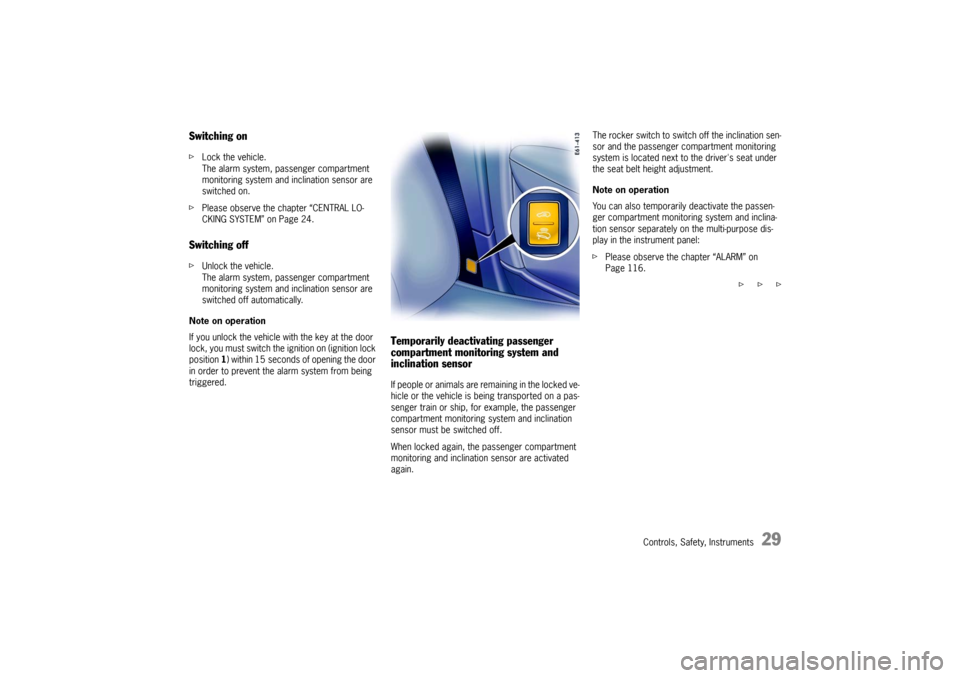
Controls, Safety, Instruments
29
Switching onfLock the vehicle.
The alarm system, passenger compartment
monitoring system and inclination sensor are
switched on.
fPlease observe the chapter “CENTRAL LO-
CKING SYSTEM” on Page 24.Switching offfUnlock the vehicle.
The alarm system, passenger compartment
monitoring system and inclination sensor are
switched off automatically.
Note on operation
If you unlock the vehicle with the key at the door
lock, you must switch the ignition on (ignition lock
position 1) within 15 seconds of opening the door
in order to prevent the alarm system from being
triggered.
Temporarily deactivating passenger
compartment monitoring system and
inclination sensorIf people or animals are remaining in the locked ve-
hicle or the vehicle is being transported on a pas-
senger train or ship, for example, the passenger
compartment monitoring system and inclination
sensor must be switched off.
When locked again, the passenger compartment
monitoring and inclination sensor are activated
again.The rocker switch to switch off the inclination sen-
sor and the passenger compartment monitoring
system is located next to the driver's seat under
the seat belt height adjustment.
Note on operation
You can also temporarily deactivate the passen-
ger compartment monitoring system and inclina-
tion sensor separately on the multi-purpose dis-
play in the instrument panel:
fPlease observe the chapter “ALARM” on
Page 116.
f f f
Page 36 of 387
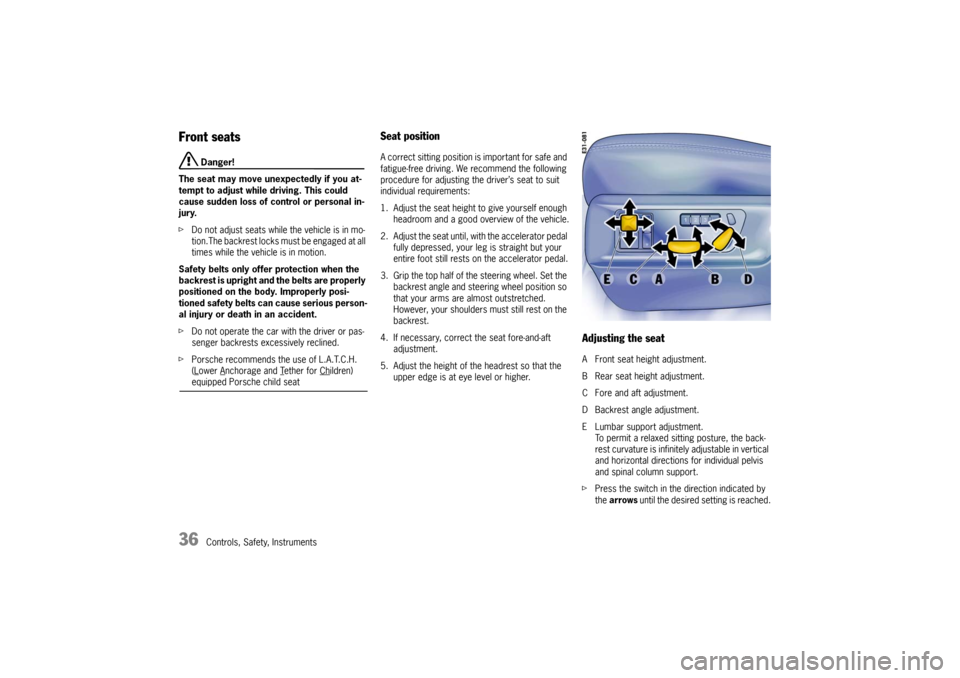
36
Controls, Safety, Instruments
Front seats
Danger!
The seat may move unexpectedly if you at-
tempt to adjust while driving. This could
cause sudden loss of control or personal in-
jury.
fDo not adjust seats while the vehicle is in mo-
tion.The backrest locks must be engaged at all
times while the vehicle is in motion.
Safety belts only offer protection when the
backrest is upright and the belts are properly
positioned on the body. Improperly posi-
tioned safety belts can cause serious person-
al injury or death in an accident.
fDo not operate the car with the driver or pas-
senger backrests excessively reclined.
fPorsche recommends the use of L.A.T.C.H.
(Lower A
nchorage and T
ether for Ch
ildren)
equipped Porsche child seat
Seat positionA correct sitting position is important for safe and
fatigue-free driving. We recommend the following
procedure for adjusting the driver’s seat to suit
individual requirements:
1. Adjust the seat height to give yourself enough
headroom and a good overview of the vehicle.
2. Adjust the seat until, with the accelerator pedal
fully depressed, your leg is straight but your
entire foot still rests on the accelerator pedal.
3. Grip the top half of the steering wheel. Set the
backrest angle and steering wheel position so
that your arms are almost outstretched.
However, your shoulders must still rest on the
backrest.
4. If necessary, correct the seat fore-and-aft
adjustment.
5. Adjust the height of the headrest so that the
upper edge is at eye level or higher.
Adjusting the seatA Front seat height adjustment.
B Rear seat height adjustment.
C Fore and aft adjustment.
D Backrest angle adjustment.
E Lumbar support adjustment.
To permit a relaxed sitting posture, the back-
rest curvature is infinitely adjustable in vertical
and horizontal directions for individual pelvis
and spinal column support.
fPress the switch in the direction indicated by
the arrows until the desired setting is reached.
Page 37 of 387
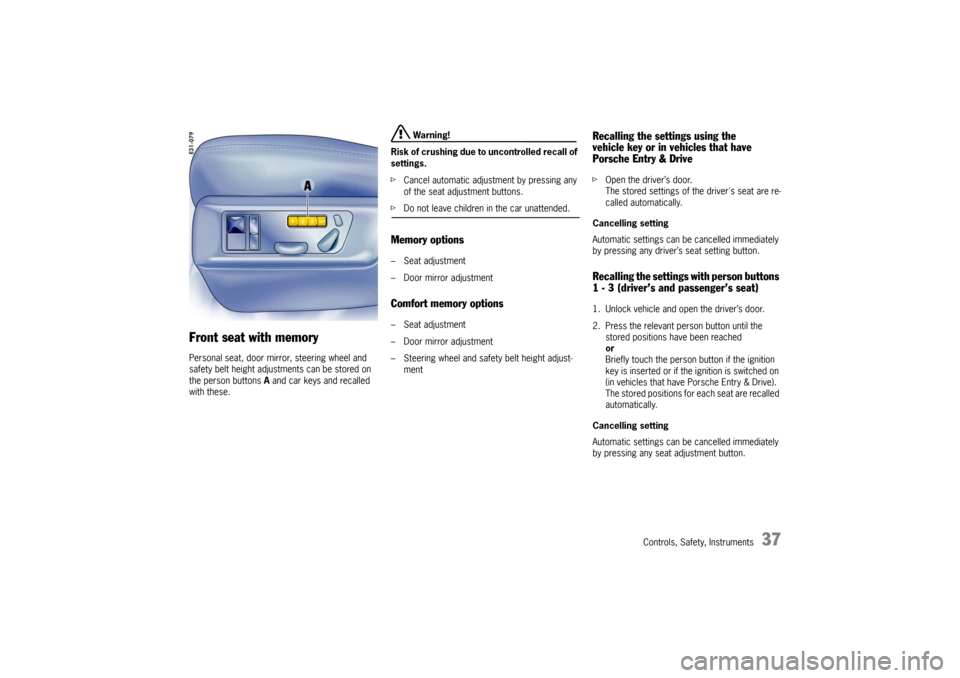
Controls, Safety, Instruments
37
Front seat with memoryPersonal seat, door mirror, steering wheel and
safety belt height adjustments can be stored on
the person buttons A and car keys and recalled
with these.
Warning!
Risk of crushing due to uncontrolled recall of
settings.
fCancel automatic adjustment by pressing any
of the seat adjustment buttons.
fDo not leave children in the car unattended.Memory options–Seat adjustment
– Door mirror adjustmentComfort memory options–Seat adjustment
– Door mirror adjustment
– Steering wheel and safety belt height adjust-
ment
Recalling the settings using the
vehicle key or in vehicles that have
Porsche Entry & DrivefOpen the driver’s door.
The stored settings of the driver's seat are re-
called automatically.
Cancelling setting
Automatic settings can be cancelled immediately
by pressing any driver’s seat setting button.Recalling the settings with person buttons
1 - 3 (driver’s and passenger’s seat)1. Unlock vehicle and open the driver’s door.
2. Press the relevant person button until the
stored positions have been reached
or
Briefly touch the person button if the ignition
key is inserted or if the ignition is switched on
(in vehicles that have Porsche Entry & Drive).
The stored positions for each seat are recalled
automatically.
Cancelling setting
Automatic settings can be cancelled immediately
by pressing any seat adjustment button.
Page 38 of 387
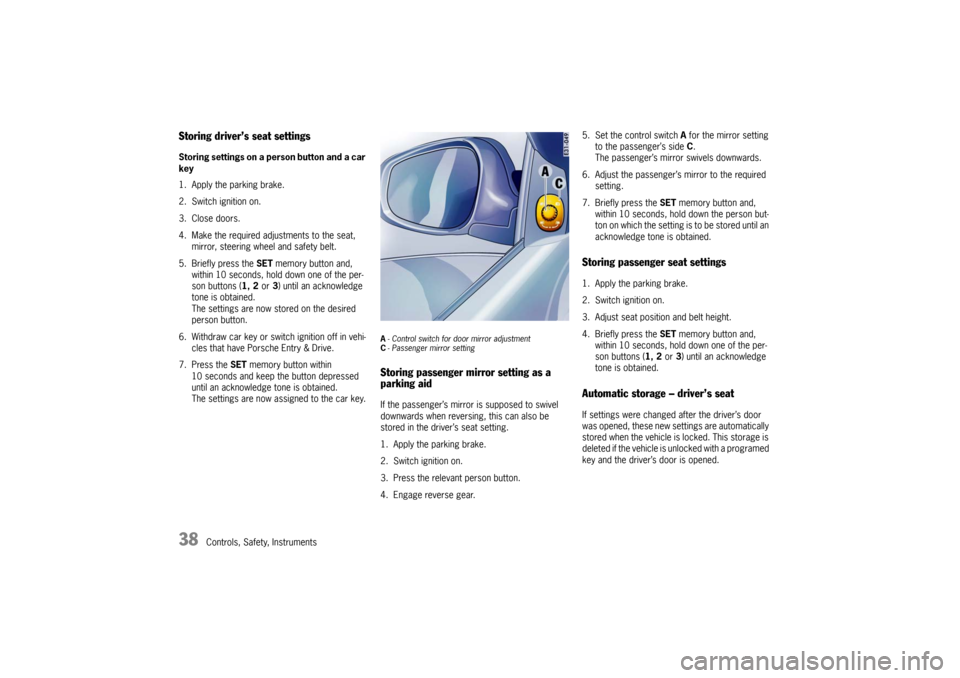
38
Controls, Safety, Instruments
Storing driver’s seat settingsStoring settings on a person button and a car
key
1. Apply the parking brake.
2. Switch ignition on.
3. Close doors.
4. Make the required adjustments to the seat,
mirror, steering wheel and safety belt.
5. Briefly press the SET memory button and,
within 10 seconds, hold down one of the per-
son buttons (1, 2 or 3) until an acknowledge
tone is obtained.
The settings are now stored on the desired
person button.
6. Withdraw car key or switch ignition off in vehi-
cles that have Porsche Entry & Drive.
7. Press the SET memory button within
10 seconds and keep the button depressed
until an acknowledge tone is obtained.
The settings are now assigned to the car key.
A- Control switch for door mirror adjustment
C- Passenger mirror settingStoring passenger mirror setting as a
parking aidIf the passenger’s mirror is supposed to swivel
downwards when reversing, this can also be
stored in the driver’s seat setting.
1. Apply the parking brake.
2. Switch ignition on.
3. Press the relevant person button.
4. Engage reverse gear.5. Set the control switch A for the mirror setting
to the passenger’s side C.
The passenger’s mirror swivels downwards.
6. Adjust the passenger’s mirror to the required
setting.
7. Briefly press the SET memory button and,
within 10 seconds, hold down the person but-
ton on which the setting is to be stored until an
acknowledge tone is obtained.
Storing passenger seat settings1. Apply the parking brake.
2. Switch ignition on.
3. Adjust seat position and belt height.
4. Briefly press the SET memory button and,
within 10 seconds, hold down one of the per-
son buttons (1, 2 or 3) until an acknowledge
tone is obtained.Automatic storage – driver’s seatIf settings were changed after the driver’s door
was opened, these new settings are automatically
stored when the vehicle is locked. This storage is
deleted if the vehicle is unlocked with a programed
key and the driver’s door is opened.
Page 43 of 387
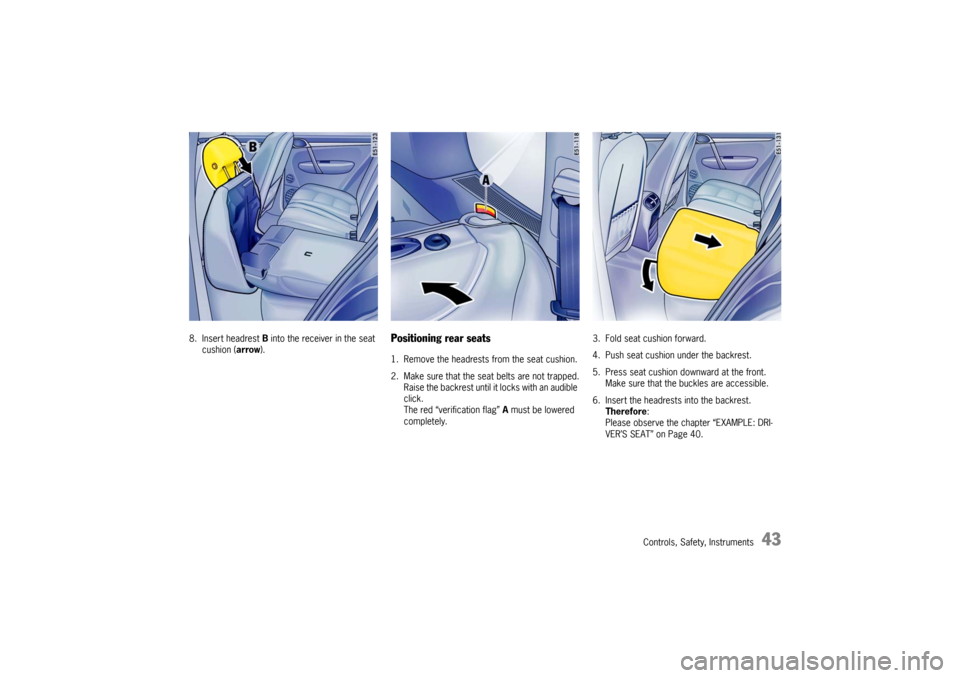
Controls, Safety, Instruments
43
8. Insert headrest B into the receiver in the seat
cushion (arrow).
Positioning rear seats1. Remove the headrests from the seat cushion.
2. Make sure that the seat belts are not trapped.
Raise the backrest until it locks with an audible
click.
The red “verification flag” A must be lowered
completely.3. Fold seat cushion forward.
4. Push seat cushion under the backrest.
5. Press seat cushion downward at the front.
Make sure that the buckles are accessible.
6. Insert the headrests into the backrest.
Therefore:
Please observe the chapter “EXAMPLE: DRI-
VER’S SEAT” on Page 40.
Page 46 of 387

46
Controls, Safety, Instruments
Safety Belts
Danger!
Always make sure your and your passengers'
safety belts are properly fastened while the
vehicle is in motion.
Failure to follow safety belt warnings may re-
sult in serious personal injury or death.
fFor your and your passengers' protection, use
safety belts at all times while the vehicle is in
motion.
fUse appropriate child restraint systems for all
small children.
Proper wearing of safety belts
fS a f e t y b e l t s m u s t b e p o s i t i o n e d o n t h e b o d y a s
to restrain the upper body and lap from sliding
forward. Improperly positioned safety belts
can cause serious personal injury in case of an
accident.
fThe shoulder belt should always rest on your
upper body. The shoulder belt should never be
worn behind your back or under your arm.
fFor maximum effectiveness, the lap belt
should be worn low across the hips.
fPregnant women should position the belt as
low as possible across the pelvis. Make sure it
is not pressing against the abdomen.
fBelts should not be worn twisted.fDo not wear belts over rigid or breakable
objects in or on your clothing, such as eye
glasses, pens, keys, etc. as these may cause
injury.
fSeveral layers of heavy clothing may interfere
with proper positioning of belts.
fBelts must not rub against sharp objects or
damage may occur to the belt.
fTwo occupants should never share the same
belt at the same time.
Care and maintenance
fKeep belt buckles free of any obstruction that
may prevent a secure locking.
fBelts that have been subjected to excessive
stretch forces in an accident must be inspect-
ed or replaced to ensure their continued effec-
tiveness in restraining you.
The same applies to belt tensioner systems
which have been triggered. In addition, the an-
chor points of the belts should be checked.
fIf safety belts do not work properly, see your
authorized Porsche dealer immediately.
fI f t h e b e l t s s h o w d a m a g e t o w e b b i n g , b i n d i n g s ,
buckles or retractors, they should be replaced
to ensure safe operation.
fDo not modify or disassemble the safety belts
in your vehicle.fThe belts must be kept clean or the retractors
may not work properly.
Please observe the chapter “CAR CARE IN-
STRUCTIONS” on Page 273.
fNever bleach or dye safety belts.
fDo not allow safety belts to retract until they
are completely dry after cleaning or this may
cause damage to the belt.
Page 47 of 387

Controls, Safety, Instruments
47
Belt tensionerDepending on the force of a collision, fastened
seat belts are automatically tightened in an acci-
dent.
The belt tensioners are triggered in:
– Front and rear impacts
– Side impacts (only belt tensioners of the front
seats are triggered)
Maintenance note
The belt tensioner system can be triggered only
once; the system must be replaced afterwards.
If there is a fault in the belt tensioner system, the
airbag warning light lights up.
Work may be performed on the belt tensioner
system only by an authorized Porsche dealer.
Smoke is released when the belt tensioners are
triggered.
This does not indicate a fire in the vehicle.An audio-visual warning system is interconnect-
ed with the driver’s safety belt.
Every time the ignition is turned on, the gong will
sound for about 6 seconds to remind driver and
passenger to buckle up.
In addition, the gong will sound if vehicle speed ex-
ceeds 6mph (10 km/h).
The safety belt warning lights in the instrument
panel and in the multi-purpose display will go off as
soon as the driver has buckled up.
Warning lights and warning
messages